TOYOTA MIRAI 2023 Owners Manual
Manufacturer: TOYOTA, Model Year: 2023, Model line: MIRAI, Model: TOYOTA MIRAI 2023Pages: 572, PDF Size: 17.71 MB
Page 211 of 572
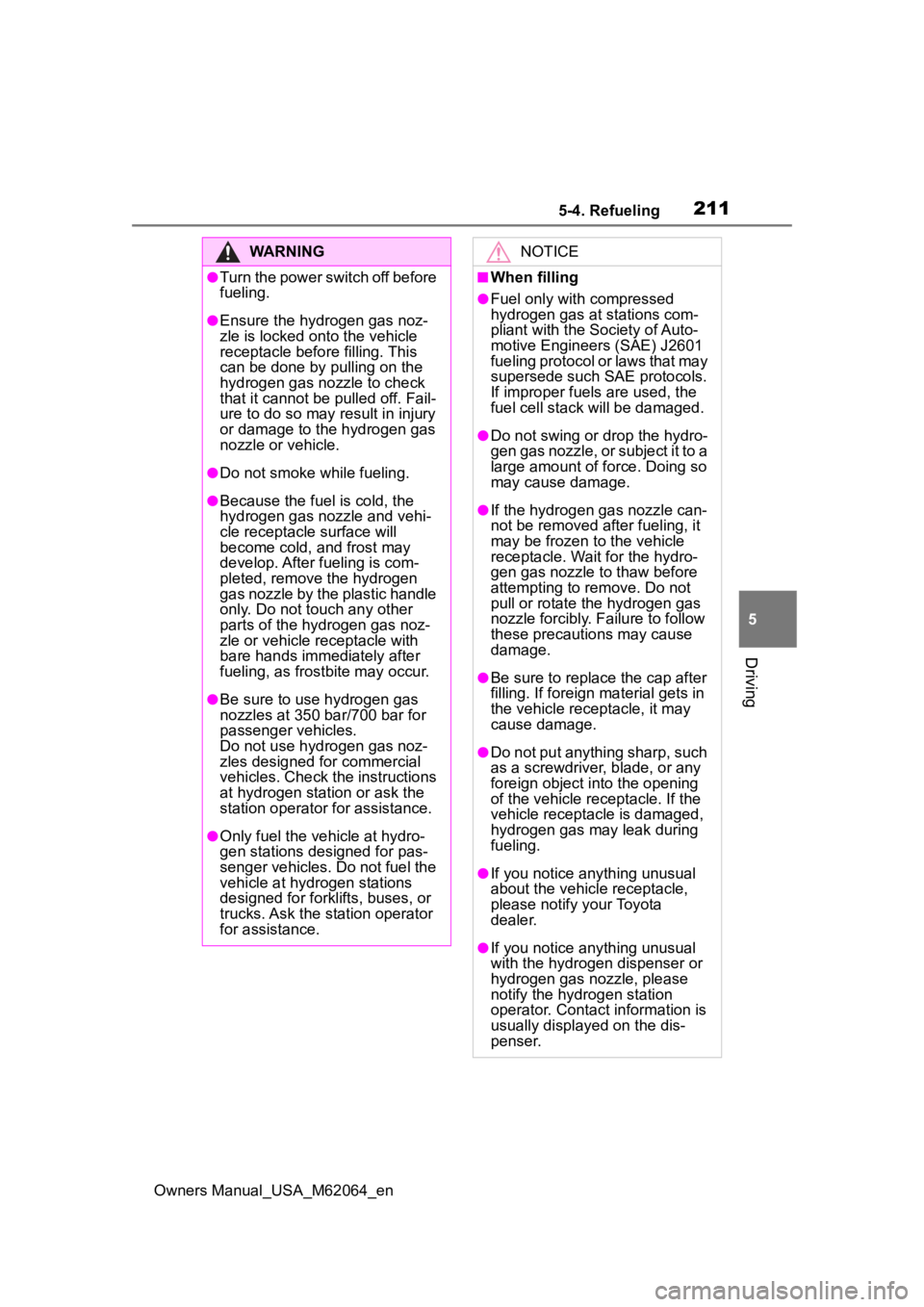
2115-4. Refueling
Owners Manual_USA_M62064_en
5
Driving
WARNING
●Turn the power switch off before
fueling.
●Ensure the hydrogen gas noz-
zle is locked onto the vehicle
receptacle before filling. This
can be done by pulling on the
hydrogen gas no zzle to check
that it cannot be pulled off. Fail-
ure to do so may result in injury
or damage to the hydrogen gas
nozzle or vehicle.
●Do not smoke while fueling.
●Because the fuel is cold, the
hydrogen gas nozzle and vehi-
cle receptacle surface will
become cold, and frost may
develop. After fueling is com-
pleted, remove the hydrogen
gas nozzle by the plastic handle
only. Do not touch any other
parts of the hydrogen gas noz-
zle or vehicle receptacle with
bare hands immediately after
fueling, as frostbite may occur.
●Be sure to use hydrogen gas
nozzles at 350 bar/700 bar for
passenger vehicles.
Do not use hydrogen gas noz-
zles designed for commercial
vehicles. Check the instructions
at hydrogen station or ask the
station operator for assistance.
●Only fuel the vehicle at hydro-
gen stations designed for pas-
senger vehicles. Do not fuel the
vehicle at hydrogen stations
designed for forklifts, buses, or
trucks. Ask the station operator
for assistance.
NOTICE
■When filling
●Fuel only with compressed
hydrogen gas at stations com-
pliant with the Society of Auto-
motive Engineers (SAE) J2601
fueling protocol or laws that may
supersede such SAE protocols.
If improper fuels are used, the
fuel cell stack will be damaged.
●Do not swing or drop the hydro-
gen gas nozzle, or subject it to a
large amount of force. Doing so
may cause damage.
●If the hydrogen gas nozzle can-
not be removed after fueling, it
may be frozen to the vehicle
receptacle. Wait for the hydro-
gen gas nozzle to thaw before
attempting to r emove. Do not
pull or rotate the hydrogen gas
nozzle forcibly. Failure to follow
these precautions may cause
damage.
●Be sure to replace the cap after
filling. If foreign ma terial gets in
the vehicle receptacle, it may
cause damage.
●Do not put anything sharp, such
as a screwdriver, blade, or any
foreign object into the opening
of the vehicle receptacle. If the
vehicle receptacle is damaged,
hydrogen gas may leak during
fueling.
●If you notice anything unusual
about the vehicle receptacle,
please notify your Toyota
dealer.
●If you notice anything unusual
with the hydrogen dispenser or
hydrogen gas nozzle, please
notify the hydrogen station
operator. Contact information is
usually displayed on the dis-
penser.
Page 212 of 572
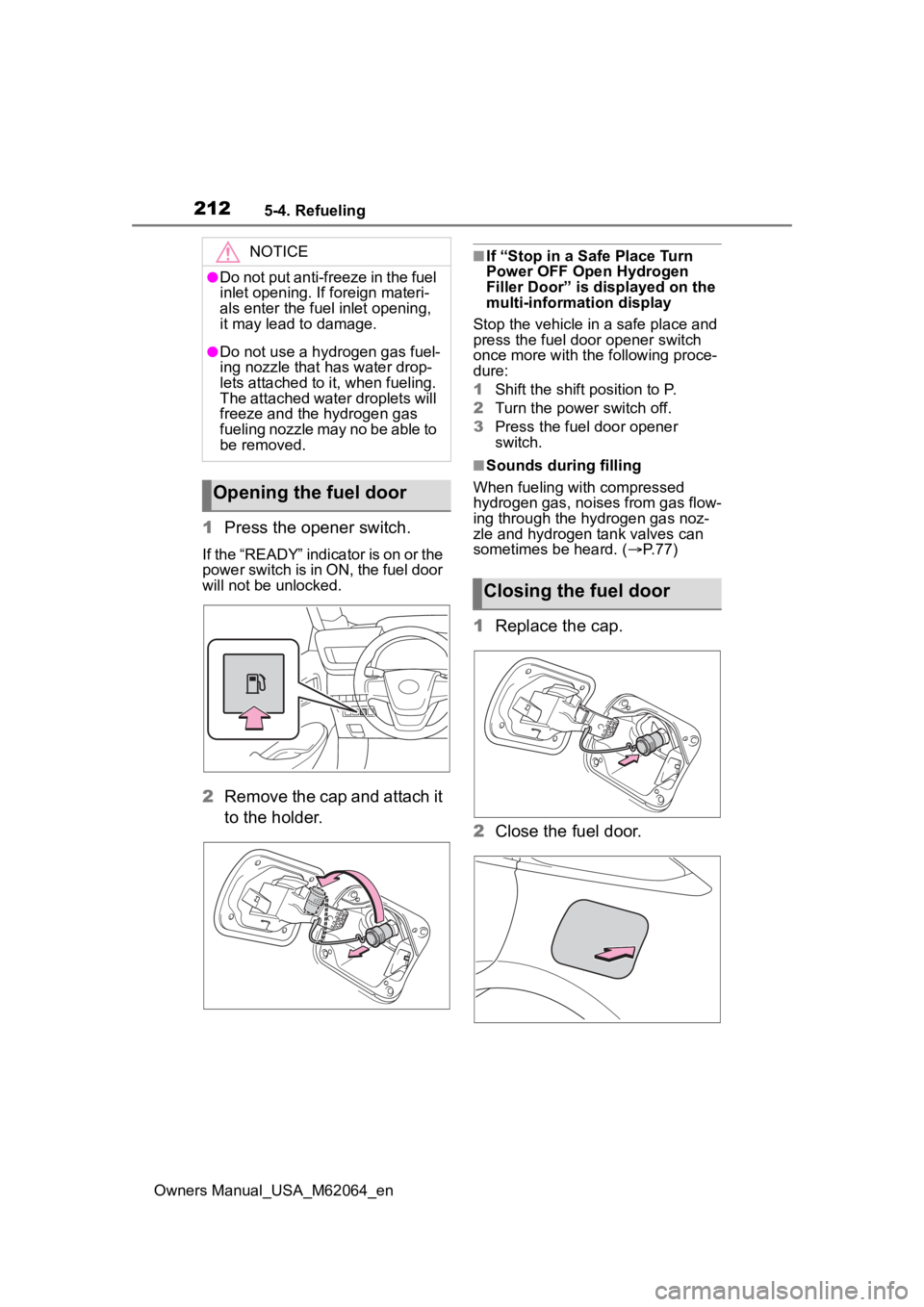
2125-4. Refueling
Owners Manual_USA_M62064_en
1Press the opener switch.
If the “READY” indicator is on or the
power switch is in ON, the fuel door
will not be unlocked.
2Remove the cap and attach it
to the holder.
■If “Stop in a Safe Place Turn
Power OFF Open Hydrogen
Filler Door” is displayed on the
multi-information display
Stop the vehicle in a safe place and
press the fuel door opener switch
once more with the following proce-
dure:
1 Shift the shift position to P.
2 Turn the power switch off.
3 Press the fuel door opener
switch.
■Sounds during filling
When fueling with compressed
hydrogen gas, noises from gas flow-
ing through the hydrogen gas noz-
zle and hydrogen tank valves can
sometimes be heard. ( P. 7 7 )
1Replace the cap.
2 Close the fuel door.
NOTICE
●Do not put anti-freeze in the fuel
inlet opening. If foreign materi-
als enter the fuel inlet opening,
it may lead to damage.
●Do not use a hydrogen gas fuel-
ing nozzle that has water drop-
lets attached to it, when fueling.
The attached water droplets will
freeze and the hydrogen gas
fueling nozzle may no be able to
be removed.
Opening the fuel door
Closing the fuel door
Page 213 of 572

2135-4. Refueling
Owners Manual_USA_M62064_en
5
Driving
■Error operation prevention
function
When the fuel door is open, the fuel
cell system will not start. When the
“READY” indicator is on, the fuel
door will not open.
■If “Open Filler Door Detected
Stop in a Safe Place Close
Hydrogen Filler Door” is dis-
played on the multi-information
display
The fuel door is open. Stop the vehi-
cle in a safe place and close the fuel
door.
■If “Open Filler Door Detected
Close Hydrogen Filler Door
Restart Vehicle” is displayed on
the multi-information display
The fuel door is open and the fuel
cell system cannot be started. Shift
the shift position to P and, turn the
power switch off, then:
1 Check whether the cap has been
reinstalled.
2 Close the fuel door.
If the warning message on the multi-
information display turns off at this
time, there is no malfunction. How-
ever, if the display continues to
show, the sensor may be damaged.
Have the vehicle inspected by your
Toyota dealer.
It can be started 1 time at intervals
of repeating the st arting operations
5 times (With the brake pedal
depress, press the power switch
operations 9 times within the inter-
val of 2 seconds). Operate the vehi-
cle after checking to be sure that the
hydrogen fueling nozzle is not con-
nected to the vehicle.
Page 214 of 572
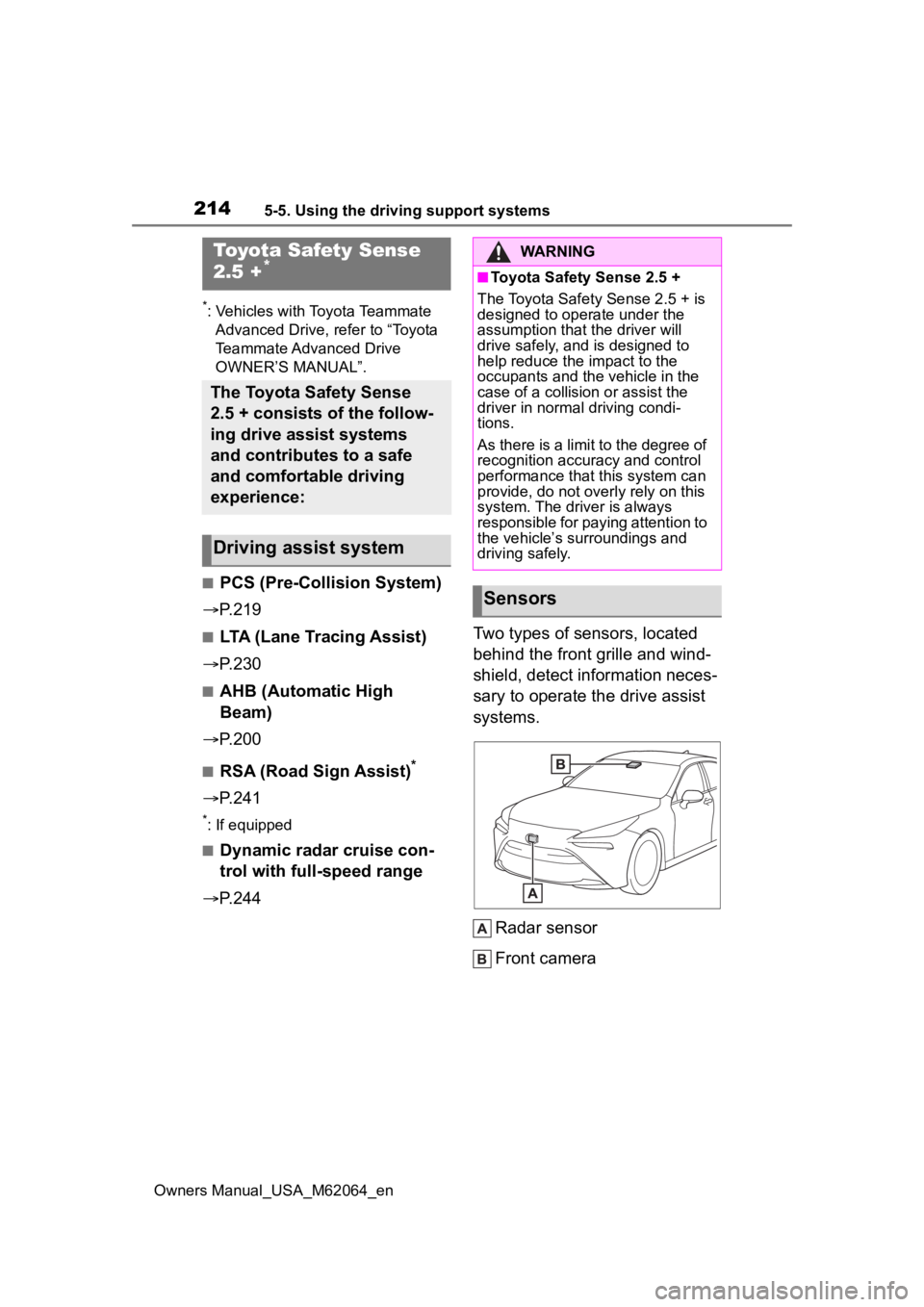
2145-5. Using the driving support systems
Owners Manual_USA_M62064_en
5-5.Using the driving support systems
*: Vehicles with Toyota Teammate Advanced Drive, re fer to “Toyota
Teammate Advanced Drive
OWNER’S MANUAL”.
■PCS (Pre-Collision System)
P.219
■LTA (Lane Tracing Assist)
P.230
■AHB (Automatic High
Beam)
P.200
■RSA (Road Sign Assist)*
P.241
*: If equipped
■Dynamic radar cruise con-
trol with full-speed range
P.244 Two types of sensors, located
behind the front grille and wind-
shield, detect information neces-
sary to operate the drive assist
systems.
Radar sensor
Front camera
Toyota Safety Sense
2.5 +*
The Toyota Safety Sense
2.5 + consists of the follow-
ing drive assist systems
and contributes to a safe
and comfortable driving
experience:
Driving assist system
WARNING
■Toyota Safety Sense 2.5 +
The Toyota Safety Sense 2.5 + is
designed to operate under the
assumption that the driver will
drive safely, and is designed to
help reduce the impact to the
occupants and the vehicle in the
case of a collision or assist the
driver in normal driving condi-
tions.
As there is a limit to the degree of
recognition accuracy and control
performance that this system can
provide, do not overly rely on this
system. The driver is always
responsible for paying attention to
the vehicle’s su rroundings and
driving safely.
Sensors
Page 215 of 572
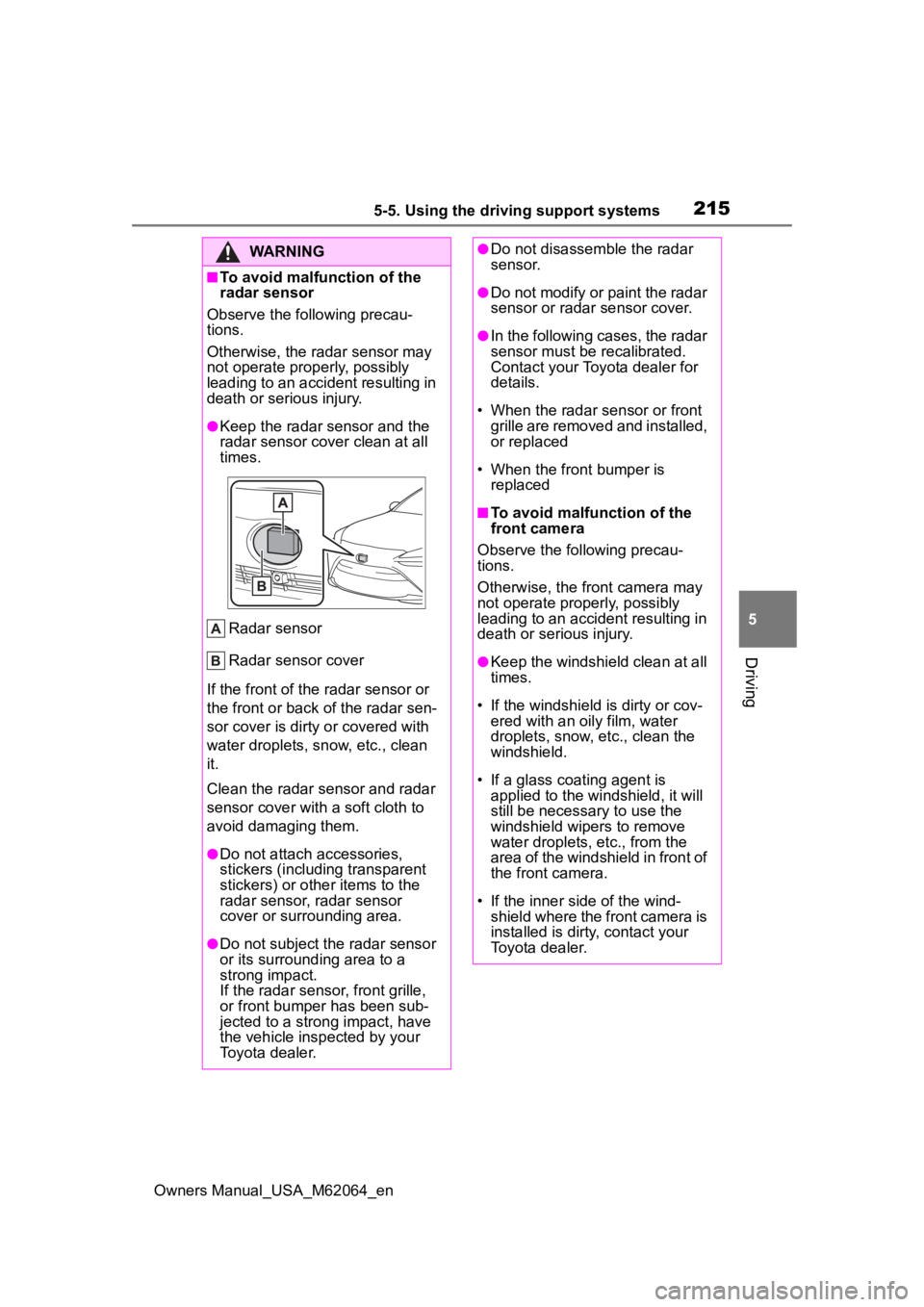
2155-5. Using the driving support systems
Owners Manual_USA_M62064_en
5
Driving
WARNING
■To avoid malfunction of the
radar sensor
Observe the following precau-
tions.
Otherwise, the radar sensor may
not operate properly, possibly
leading to an accident resulting in
death or serious injury.
●Keep the radar sensor and the
radar sensor cover clean at all
times.
Radar sensor
Radar sensor cover
If the front of the r adar sensor or
the front or back of the radar sen-
sor cover is dirty or covered with
water droplets, snow, etc., clean
it.
Clean the radar sensor and radar
sensor cover with a soft cloth to
avoid damaging them.
●Do not attach accessories,
stickers (including transparent
stickers) or other items to the
radar sensor, radar sensor
cover or surrounding area.
●Do not subject the radar sensor
or its surrounding area to a
strong impact.
If the radar sensor, front grille,
or front bumper has been sub-
jected to a strong impact, have
the vehicle insp ected by your
Toyota dealer.
●Do not disassemble the radar
sensor.
●Do not modify or paint the radar
sensor or radar sensor cover.
●In the following cases, the radar
sensor must be recalibrated.
Contact your Toyota dealer for
details.
• When the radar s ensor or front
grille are removed and installed,
or replaced
• When the front bumper is replaced
■To avoid malfunction of the
front camera
Observe the following precau-
tions.
Otherwise, the f ront camera may
not operate properly, possibly
leading to an accident resulting in
death or serious injury.
●Keep the windshield clean at all
times.
• If the windshield is dirty or cov-
ered with an o ily film, water
droplets, snow, etc., clean the
windshield.
• If a glass coating agent is applied to the windshield, it will
still be necessary to use the
windshield wipers to remove
water droplets, etc., from the
area of the windshield in front of
the front camera.
• If the inner side of the wind- shield where the front camera is
installed is dirty, contact your
Toyota dealer.
Page 216 of 572
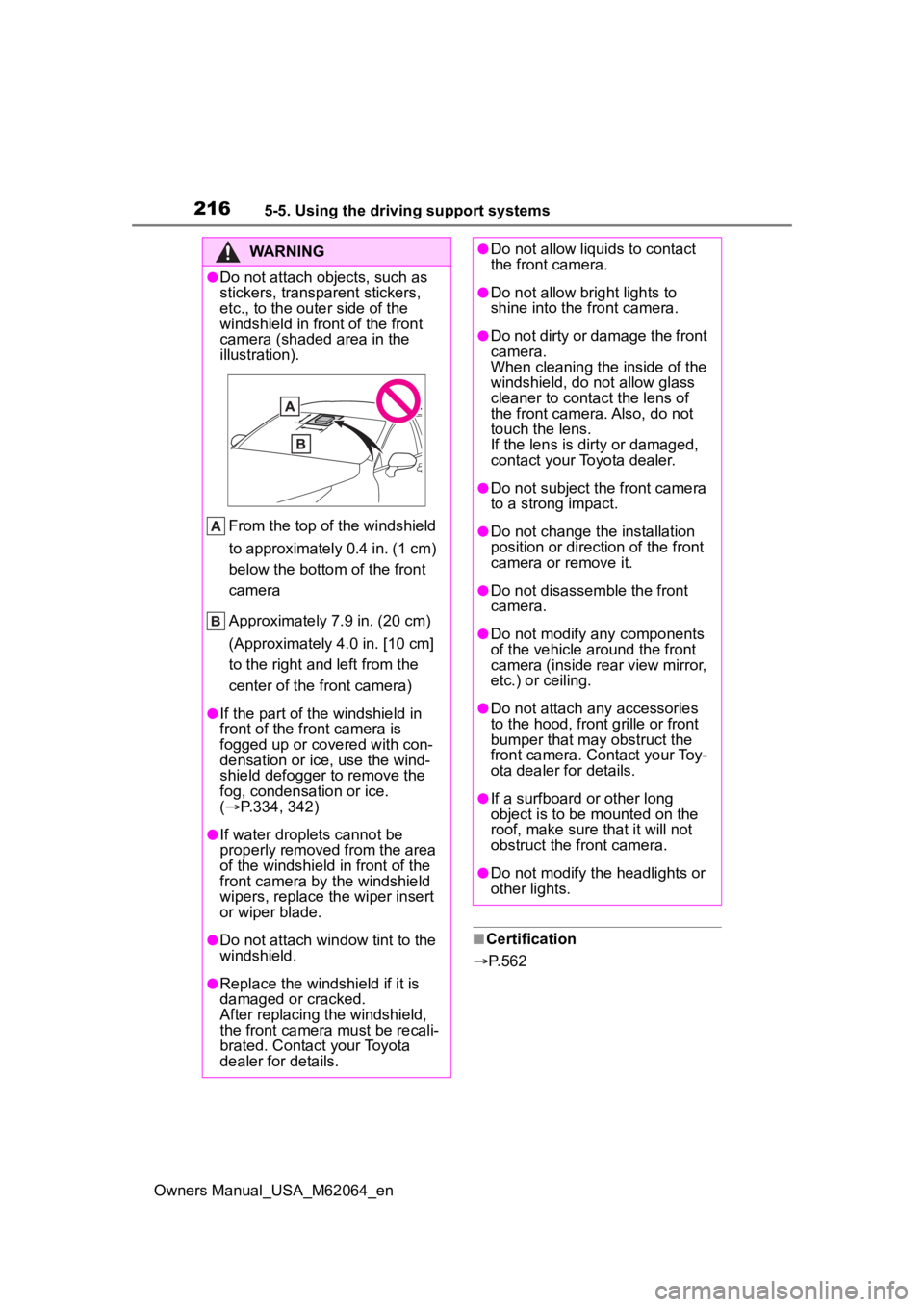
2165-5. Using the driving support systems
Owners Manual_USA_M62064_en
■Certification
P.562
WARNING
●Do not attach objects, such as
stickers, transparent stickers,
etc., to the oute r side of the
windshield in fr ont of the front
camera (shaded area in the
illustration).
From the top of the windshield
to approximately 0.4 in. (1 cm)
below the bottom of the front
camera
Approximately 7.9 in. (20 cm)
(Approximately 4.0 in. [10 cm]
to the right and left from the
center of the front camera)
●If the part of the windshield in
front of the front camera is
fogged up or covered with con-
densation or ice, use the wind-
shield defogger to remove the
fog, condensation or ice.
( P.334, 342)
●If water droplets cannot be
properly removed from the area
of the windshield in front of the
front camera by the windshield
wipers, replace the wiper insert
or wiper blade.
●Do not attach win dow tint to the
windshield.
●Replace the windshield if it is
damaged or cracked.
After replacing the windshield,
the front camera must be recali-
brated. Contact your Toyota
dealer for details.
●Do not allow liquids to contact
the front camera.
●Do not allow bright lights to
shine into the front camera.
●Do not dirty or damage the front
camera.
When cleaning the inside of the
windshield, do not allow glass
cleaner to contact the lens of
the front camera. Also, do not
touch the lens.
If the lens is dirty or damaged,
contact your Toyota dealer.
●Do not subject the front camera
to a strong impact.
●Do not change the installation
position or direction of the front
camera or remove it.
●Do not disassemble the front
camera.
●Do not modify any components
of the vehicle around the front
camera (inside rear view mirror,
etc.) or ceiling.
●Do not attach any accessories
to the hood, front grille or front
bumper that may obstruct the
front camera. Contact your Toy-
ota dealer for details.
●If a surfboard or other long
object is to be mounted on the
roof, make sure that it will not
obstruct the front camera.
●Do not modify the headlights or
other lights.
Page 217 of 572
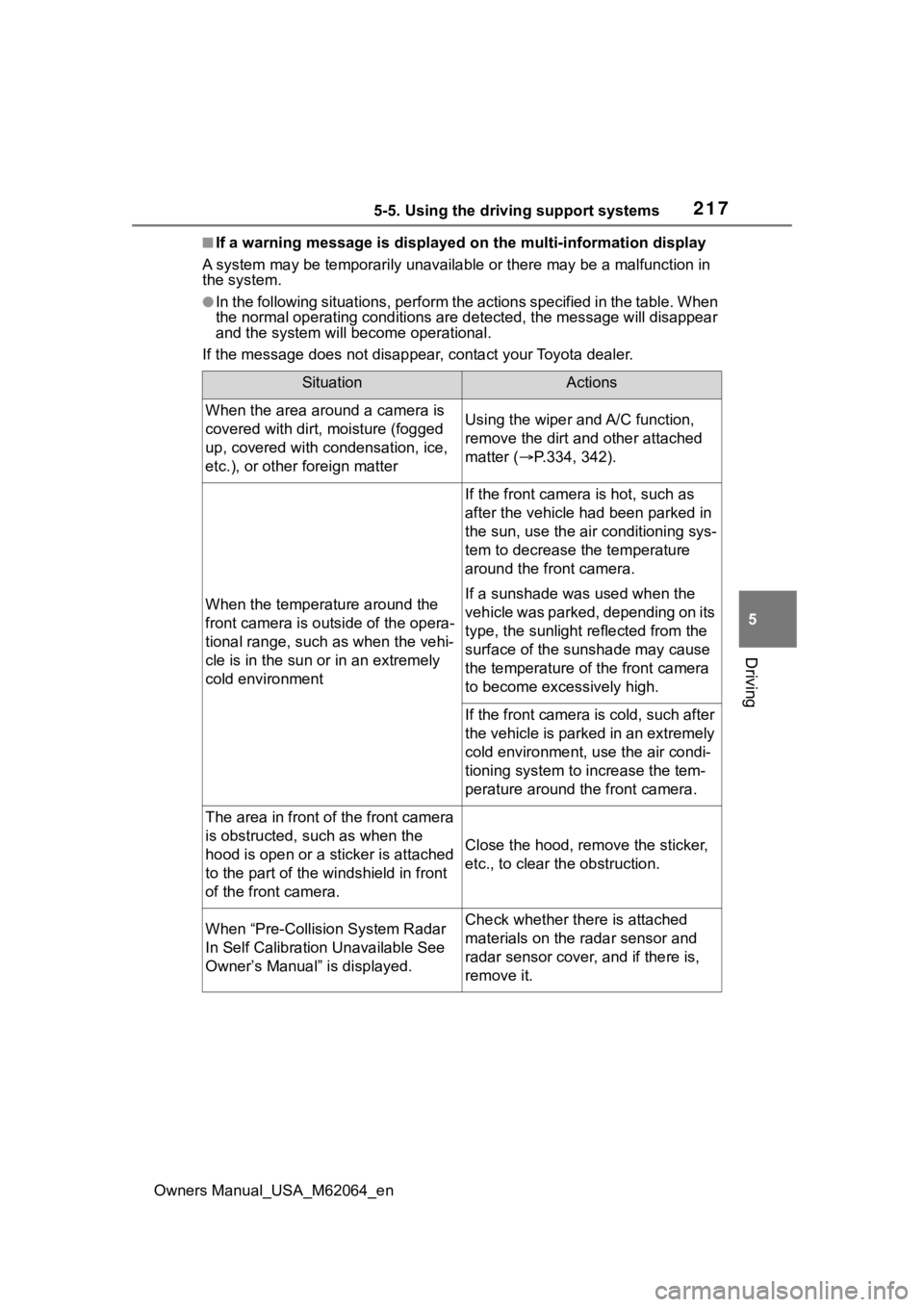
2175-5. Using the driving support systems
Owners Manual_USA_M62064_en
5
Driving
■If a warning message is displayed on the multi-information disp lay
A system may be tempor arily unavailable or there may be a malfu nction in
the system.
●In the following situations, perform the actions specified in t he table. When
the normal operating conditions are detected, the message will disappear
and the system will be come operational.
If the message does not disapp ear, contact your Toyota dealer.
SituationActions
When the area around a camera is
covered with dirt, moisture (fogged
up, covered with condensation, ice,
etc.), or other foreign matterUsing the wiper and A/C function,
remove the dirt and other attached
matter ( P.334, 342).
When the temperature around the
front camera is outside of the opera-
tional range, such as when the vehi-
cle is in the sun or in an extremely
cold environment
If the front camera is hot, such as
after the vehicle had been parked in
the sun, use the air conditioning sys-
tem to decrease the temperature
around the front camera.
If a sunshade was used when the
vehicle was parked, depending on its
type, the sunlight reflected from the
surface of the sunshade may cause
the temperature of the front camera
to become excessively high.
If the front camera is cold, such after
the vehicle is parked in an extremely
cold environment, use the air condi-
tioning system to increase the tem-
perature around the front camera.
The area in front o f the front camera
is obstructed, such as when the
hood is open or a sticker is attached
to the part of the win dshield in front
of the front camera.
Close the hood, rem ove the sticker,
etc., to clear the obstruction.
When “Pre-Collisio n System Radar
In Self Calibration Unavailable See
Owner’s Manual” is displayed.Check whether there is attached
materials on the radar sensor and
radar sensor cover, and if there is,
remove it.
Page 218 of 572

2185-5. Using the driving support systems
Owners Manual_USA_M62064_en
●In the following situations, if the situation has changed (or the vehicle has
been driven for some time) and the normal operating conditions are
detected, the message will disappear and the system will become opera-
tional.
If the message does not disappea r, contact your Toyota dealer.
• When the temperature around the radar sensor is outside of the opera-
tional range, such as when the vehicle is in the sun or in an e xtremely cold
environment
• When the front camera cannot d etect objects in front of the vehicle, such
as when driving in the dark, sno w, or fog, or when bright lights are shining
into the front camera
• Depending on the conditions in the vicinity of the vehicle, th e radar may
judge the surrounding environment can not be properly recognize d. In that
case, “Pre-Collision System Unavailable See Owner’s Manual” is dis-
played.
Page 219 of 572
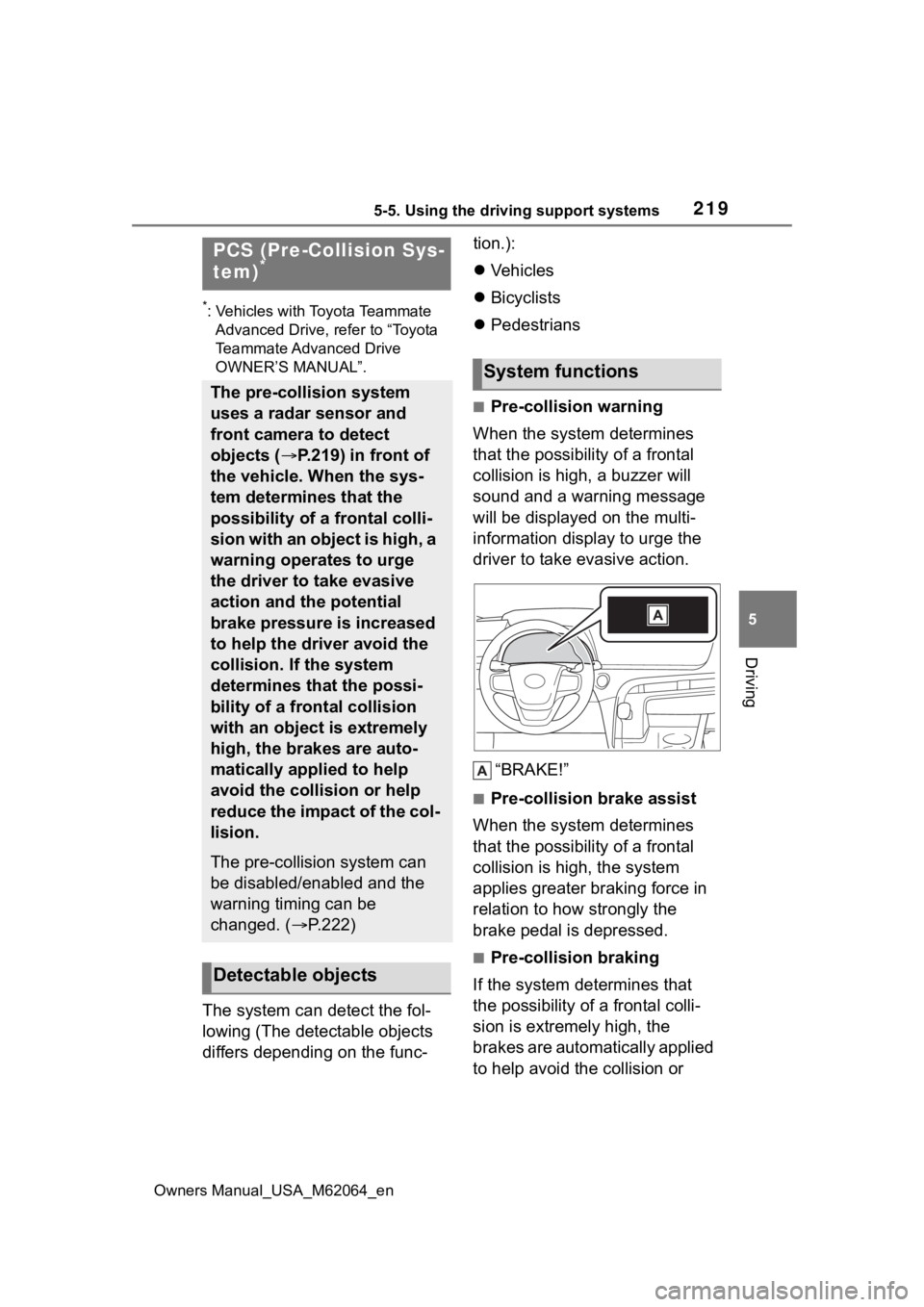
2195-5. Using the driving support systems
Owners Manual_USA_M62064_en
5
Driving
*: Vehicles with Toyota Teammate Advanced Drive, re fer to “Toyota
Teammate Advanced Drive
OWNER’S MANUAL”.
The system can detect the fol-
lowing (The detectable objects
differs depending on the func- tion.):
Vehicles
Bicyclists
Pedestrians
■Pre-collision warning
When the system determines
that the possibility of a frontal
collision is high, a buzzer will
sound and a warning message
will be displayed on the multi-
information display to urge the
driver to take evasive action.
“BRAKE!”
■Pre-collision brake assist
When the system determines
that the possibility of a frontal
collision is high, the system
applies greater braking force in
relation to how strongly the
brake pedal is depressed.
■Pre-collision braking
If the system determines that
the possibility of a frontal colli-
sion is extremely high, the
brakes are automatically applied
to help avoid the collision or
PCS (Pre-Collision Sys-
tem)*
The pre-collision system
uses a radar sensor and
front camera to detect
objects ( P.219) in front of
the vehicle. When the sys-
tem determines that the
possibility of a frontal colli-
sion with an object is high, a
warning operates to urge
the driver to take evasive
action and the potential
brake pressure is increased
to help the driver avoid the
collision. If the system
determines that the possi-
bility of a frontal collision
with an object is extremely
high, the brakes are auto-
matically applied to help
avoid the collision or help
reduce the impact of the col-
lision.
The pre-collision system can
be disabled/enabled and the
warning timing can be
changed. ( P.222)
Detectable objects
System functions
Page 220 of 572
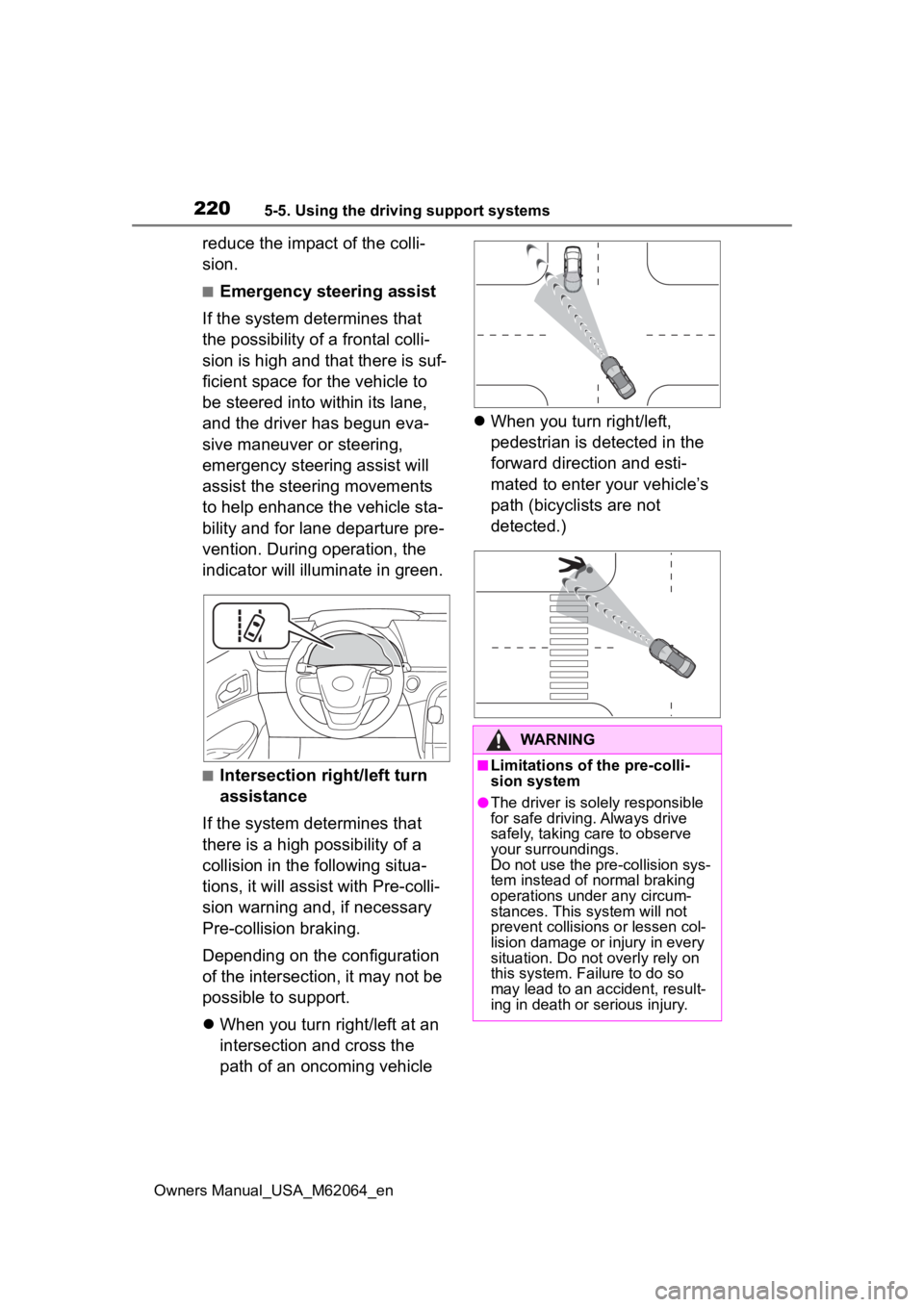
2205-5. Using the driving support systems
Owners Manual_USA_M62064_en
reduce the impact of the colli-
sion.
■Emergency steering assist
If the system determines that
the possibility of a frontal colli-
sion is high and that there is suf-
ficient space for the vehicle to
be steered into within its lane,
and the driver has begun eva-
sive maneuver or steering,
emergency steering assist will
assist the steering movements
to help enhance the vehicle sta-
bility and for lane departure pre-
vention. During operation, the
indicator will illuminate in green.
■Intersection right/left turn
assistance
If the system determines that
there is a high possibility of a
collision in the following situa-
tions, it will assist with Pre-colli-
sion warning and, if necessary
Pre-collision braking.
Depending on the configuration
of the intersection, it may not be
possible to support.
When you turn right/left at an
intersection and cross the
path of an oncoming vehicle
When you turn right/left,
pedestrian is detected in the
forward direction and esti-
mated to enter your vehicle’s
path (bicyclists are not
detected.)
WARNING
■Limitations of the pre-colli-
sion system
●The driver is solely responsible
for safe driving. Always drive
safely, taking care to observe
your surroundings.
Do not use the pre-collision sys-
tem instead of normal braking
operations under any circum-
stances. This system will not
prevent collisions or lessen col-
lision damage or injury in every
situation. Do not overly rely on
this system. Failure to do so
may lead to an accident, result-
ing in death or serious injury.